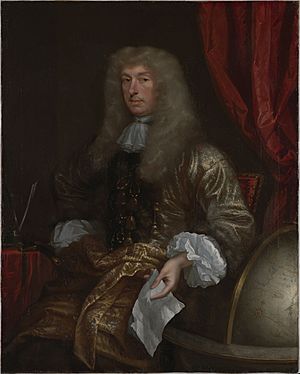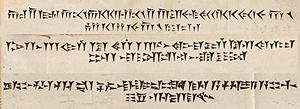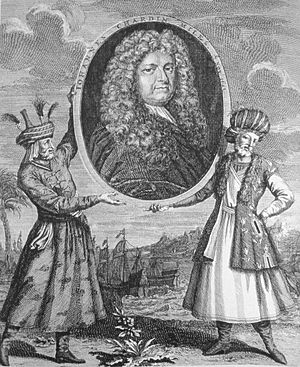Jean Chardin facts for kids
Quick facts for kids
Sir
John Chardin
|
|
|---|---|
 |
|
| Born |
Jean-Baptiste Chardin
16 November 1643 Paris, France
|
| Died | 5 January 1713 (aged 69) Chiswick, London, UK
|
| Nationality | French and British |
Jean Chardin (born Jean-Baptiste Chardin on November 16, 1643 – died January 5, 1713), also known as Sir John Chardin, was a French jeweller and explorer. He wrote a famous ten-volume book called The Travels of Sir John Chardin. This book is considered one of the best early Western studies about Persia and the Near East.
Contents
Life as an Explorer and Writer
Jean Chardin was born in Paris, France. His father was a rich merchant and jeweller. Jean followed in his father's footsteps and became a jeweller too.
In 1664, Chardin began his first big journey to the East Indies. He traveled through Constantinople (modern-day Istanbul) and across the Black Sea. He arrived in Persia in early 1666. The ruler of Persia at the time, Shah Abbas II, chose Chardin to buy jewels for him.
In 1667, Chardin visited India and then returned to Persia in 1669. He arrived back in Paris the next year. He wrote a book about some events he saw in Persia, called 'Le Couronnement de Soleiman Troisième' (The Coronation of Soleiman III). A wise nobleman in Isfahan helped him learn Persian and write this book.
Chardin started his second trip to the East in August 1671. He was in Constantinople from March to July 1672. Because of a disagreement between officials, it became dangerous for French people there. Chardin escaped by boat across the Black Sea. He had an adventurous journey through Georgia and Armenia. He finally reached Isfahan in 1673.
During his travels, he was robbed in Samegrelo and lost almost everything. But he continued his journey. He stayed in Isfahan for four years. During this time, he traveled all over Persia, from the Caspian Sea to the Persian Gulf. He also visited several cities in India. These two long journeys helped him become very wealthy. He decided to return home and reached Europe in 1677 by sailing around the Cape of Good Hope.

Chardin planned to write four volumes about his travels. The first volume was published in 1686 in London. It was called Journal du Voyage . . . de Chardin en Parse et aux Indes Orientales. An English translation was also released at the same time. This book covered his journey from Paris to Isfahan.
The complete work, Voyages de Mons. le Chevalier Chardin, was published in Amsterdam in 1711. It had many new parts added to the first volume. Later, in 1711, another edition came out in ten smaller volumes. The most complete version was published in Paris in 1811. Chardin's writing style was simple and clear. He wrote honestly about what he saw and heard. Many famous thinkers, like Montesquieu and Rousseau, praised his writings. Sir William Jones said Chardin gave the best account of Muslim nations ever published.
Life in England
In 1681, Chardin decided to live in England. This was because Protestants were being treated badly in France. He was welcomed by the English court. Soon after, he became the court jeweller. King Charles II made him a knight at Whitehall on November 17, 1681. On the same day, he married Esther, a Protestant lady from a French family who had also moved to London.
Chardin continued his successful jewel trade. People at the time called him "the flower of merchants." In 1682, he was chosen as a member of the Royal Society, a famous group for scientists. In 1684, the king sent him to Holland as an envoy. He worked there for some years as an agent for the East India Company. When he returned to London, he spent most of his time studying Eastern cultures.
Sir John Chardin died in Chiswick, London, in 1713. He was buried in Turnham Green. There is a monument to Chardin in Westminster Abbey. It has a Latin message that means "he made a name for himself by travelling."
Family
Jean Chardin had four sons and three daughters. His oldest son, John, was given the title of baronet in 1720, but he never married.
Why Chardin's Work is Important
Today, experts believe the 1711 edition of Chardin's Voyages is the most important version. Sadly, the complete book has never been fully translated into English. English versions only have less than half of the original material.
Early readers loved Chardin's work because it was very detailed and accurate. Many famous thinkers from the Enlightenment praised him, including Montesquieu, Rousseau, and Gibbon. Modern experts on Persia also agree he was very important. John Emerson said Chardin's information about Safavid Persia was better than any other Western writer's.
Chardin traveled widely and spoke Persian well. He wrote very detailed accounts of the places and people he met. He also had direct access to the Safavid court. His descriptions of the government and how things were run at the time are highly valued. Even though his books have a few small mistakes, he is generally seen as a trustworthy witness. His work has been used to study Safavid history, government, economy, culture, and art.
Images for kids
See also
 In Spanish: Jean Chardin (explorador) para niños
In Spanish: Jean Chardin (explorador) para niños



